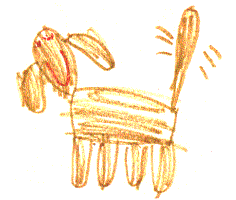Kids and Dogs

We are extremely careful about the Goldens we will place into families with children. As of June 1, 2011 Golden Bond Rescue discontinued accepting adoption applications from families with children under 10 years old.
We are seeing an alarming increase in the number of dogs that are growling, biting, or nipping at young children. Usually the biting occurs due to one or more of the following reasons:
- The child has been allowed to remove toys or food from the dog’s mouth;
- Too much activity in the household with children running and yelling;
- Toddlers carrying food in their hands;
- Little or no adult supervision of young children with their new rescue golden.
Volunteers at Golden Bond Rescue have come to realize that the majority of rescue goldens should be considered a breed apart from goldens who have lived in loving homes from puppyhood. Most rescue goldens come to us with emotional baggage and require special care, attention, and training. Small children, many at a dog’s eye level, see a golden as a play partner or stuffed animal. The quick movements of young children and their loud noises can become too much for these goldens, which has lead to injury to the children and euthanasia for the goldens.
For families with children 10-14 years old, we will only place owner-surrendered goldens which are known to be good with children. We will not place any golden that was originally a stray in a home with children who are 10-14 years old.
While actively playing with children is great fun and exercise for a golden, children cannot be expected to provide the only exercise for a Golden. Goldens are extremely active, high-energy dogs that require consistent exercise. Golden retrievers are considered puppies until they are three years of age. Their delayed adolescence period (which is the most common age during which they are surrendered to shelters or rescues) can prove to be problematic for the dog and for you if you are not prepared to commit to their needs. Behavior problems such as barking, chewing, or digging can frequently be the result of not giving a Golden enough exercise. The demand for rescued goldens with “child experience” is high, so the wait to adopt for a family with children can be lengthy. We do not want to discourage you from considering the adoption of one of our wonderful rescued goldens, but we do want you to have a realistic understanding of the probable delay.
We realize that families with children under 10 will still want to adopt a golden, possibly from another rescue group or from a shelter. If you are adding a four-legged member to your family, there are many good books about dogs and kids.
Below are some hints and ideas from Childproofing Your Dog, by Brian Kilcommons and Sarah Wilson.
S.A.F.E.
First and foremost: dogs and toddlers should never be left unsupervised. Even the most mellow dog will react when cornered by a child trying to measure the depth of the canine ear with a pencil. It is the parents’ job to keep the dog and the child S.A.F.E.
Supervise
Keep them in your vision at all times or keep them physically separated — child in play pen or dog in crate. This means ALL times. From the stories we hear, problems occur when adult eyes are elsewhere. It is amazing how fast a dog and child can make mischief together! WATCH THEM!
Anticipate
A dog has only a few ways of protesting. He can hop up on the furniture, move away or go under a bed. Once he has done this he has no other way of stopping a child other than a bark, growl or nip. If you see the dog retreating from the child, stop the child! Anticipate problems before they happen. Do not expect your dog to tolerate something that you wouldn’t.
Follow Through
If you say it, mean it. If you tell your child to stop bothering the dog, enforce that. If you tell the dog to sit, make him sit. All things are easier if your child and your dog know that you mean what you say and say what you mean.
Educate
This means child and dog. Teach your children by word and example that the animals are to be treated with care. Do not allow hitting, teasing, or other harassment. Teach your dog by practice and patience that most people — children especially — make mistakes and how to behave when mistakes are made.
If you keep both dog and child S.A.F.E., you have taken steps to prevent the preventable.


